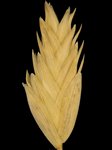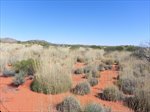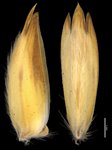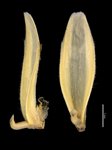
T. birriliburu spikelet.

T. birriliburu habitat.

birriliburu sheath and orifice.

T. birriliburu leaf section.

T. birriliburu lemmas.

T. birriliburu paleas.

T. birriliburu map.
Name
Triodia birriliburu B.M.Anderson, ined.
Citation
Austral. Syst. Bot., in press, (2017)
Derivation
birriliburu — an aboriginal name for the region where it is found, chosen by the traditional owners (used as a noun in apposition).Common name
Little Sandy Desert Spinifex
Synonyms
Triodia sp. Little Sandy Desert (S. van Leeuwen 4935)
Diagnostic features
Foliage non-resinous; orifice shortly pubescent with hairs <1(1.5) mm long, leaf sheath surfaces glabrous; leaf blades amphistomatous (hard-type); lower glume elliptic, 10–17-nerved; lemmas lobed for less than 1/3, or up to about 1/2 of total length, not awned, indurated for most of its length and scarcely differentiated from the slightly thinner apex, not clearly bitextured; lemma midlobe 1.5–3.8 mm long; palea flattened and with rachilla strongly diverging from palea, palea body glabrous; on or beside sand dunes in the Little Sandy Desert.
Habitat
Occurs on or beside sand dunes.
Distribution and frequency
Endemic to the Little Sandy Desert, where it is infrequent.
Similar species
Triodia birriliburu belongs to the Basedowii group, sharing the group features of non-resinous foliage, amphistomatous (hard-type) leaf blades, many-nerved (≥6) glumes and lemmas not awned.
Triodia birriliburu is distinguished from all other Basedowii-group species by having a combination of long leaves (longest leaves usually >15 cm long), a branched inflorescences with longest basal pedicels >3 mm long, glabrous leaf sheaths, orifice shortly pubescent with hairs <1(–1.5) mm long (not woolly), usually short lemma lobes (midlobe 1.5–3.8 mm long), and lemmas indurated for most of their length and scarcely differentiated into the slightly thinner apex (vs. strongly differentiated into indurated lower part and membranous upper part in most other species). The habitat on or near sand dunes in the Little Sandy desert also distinguishes T. birriliburu from all species except T. basedowii and T. infesta – for differences see under Identification without florets below.
Triodia birriliburu is similar to the Western Pilbara / Carnarvon sandplain species T. glabra in having glabrous leaf sheaths and glabrous to shortly pubescent (not woolly) orifices, but T. glabra differs in having lemmas strongly differentiated into indurated lower part and membranous upper part (indurated for most of their length and scarcely differentiated into the slightly thinner apex in T. birriliburu), paleas strongly bent in profile with the rachilla appressed (flattened and with rachilla strongly diverging from palea in T. birriliburu) and lemmas lobed for at least half their length (usually lobed for less than 1/3 of total lemma length in T. birriliburu).
Conservation status
Priority 3 recommended.
Identification without florets
The only other species with many-nerved (≥6) glumes in the Little Sandy Desert are T. basedowii and T. infesta (rare). Triodia infesta has unbranched inflorescences, compared to a branched panicle in T. basedowii and T. birriliburu.
Triodia birriliburu can be distinguished from co-occurring T. basedowii by having glabrous sheaths and shortly hairy orifices (orifices and often sheaths woolly in T. basedowii), and occurring on or immediately adjacent to dunes (usually in swales between dunes in T. basedowii).
Variation
A fairly uniform species, with some variation in the relative length (to the lemma body) of the lemma lobes, from very short to moderately long.
Notes
Co-occurs with T. basedowii in the Little Sandy Desert, without evidence of hybrids where they grow together. Triodia birriliburu grows preferentially on or adjacent to sand dunes while T. basedowii grows preferentially on swales between dunes.
Triodia birriliburu was treated under a broad concept of T. basedowii by Lazarides (1997), Lazarides et al. (2005) and Ausgrass (Sharp & Simon, 2002; Simon & Alonso, 2014). A full description of T. birriliburu can be found in Anderson et al. (2017a).